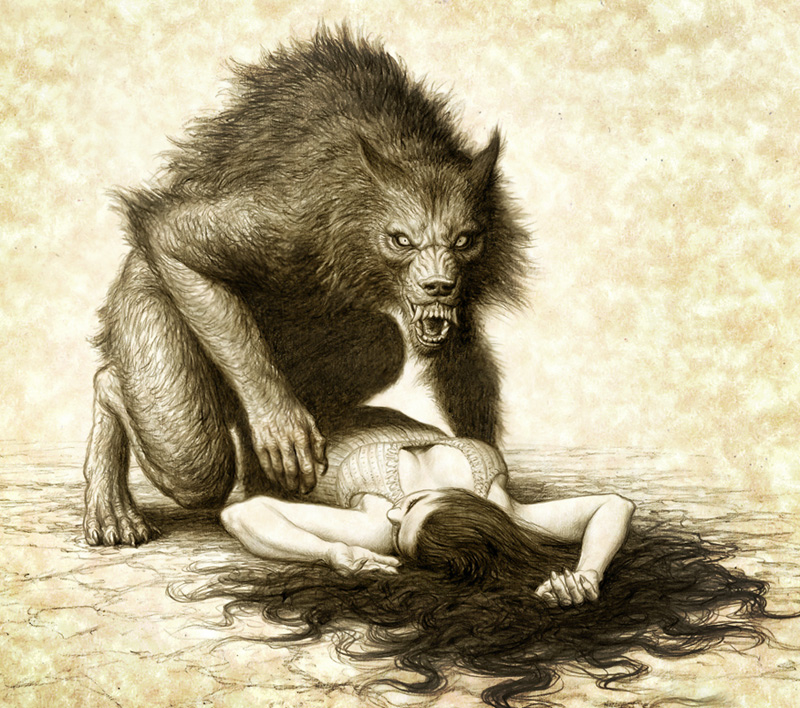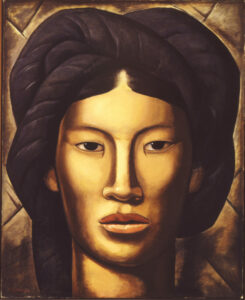Have you ever heard that at night the creatures come out, especially when there is a full moon. But whenever people think of a full moon, the thought of a werewolf might cross their mind. Because of the famous movie Twilight: New Moon, which was released in 2009, people might imagine a werewolf being Taylor Lautner turning into a huge wolf. However, before this movie was released to the big screen, werewolves were thought to be a thing of the night, actual monsters to fear.
In the past, werewolves are said to be the product of a human’s involuntary, typically only temporary, transformation into a wolf.1 They didn’t necessarily completely change into a full wolf, but had the appearance of being half-wolf and half-human. For quite some time during the medieval period, many couldn’t accept the fact that a man could transform into a wolf. They concluded that these werewolves were a product of magic, that witches used their magic to transform someone into a wolf, known as lycanthropy. With the use of magic, these werewolves were considered voluntary werewolves, as oppose to involuntary werewolves, who shifted into wolves because of their sins.2 After the transformation was made, people assumed a werewolf was a servant from the devil himself, and anyone accused of being one was put to death.3

The origins of these beliefs started in the Balkan area. In this region, the Dacians, who were an ancient people, had a wolf as their totem animal. With this being said, they believed that they were able to turn young men into wolves when performing a ritual.4 When this ritual was performed, they would imitate a wolf along with wearing wolf skins; this is because they believed the wolf should be highly respected for being a hunter. Even in Greek mythology, one can find stories about men transforming into a wolf. They told the story that the mighty Zeus became angry at a man named Lycaon, and for a punishment, he turned Lycaon into a wolf. With this story we get the term lycanthropy. However, some people believe that werewolves may be a relic of early cannibalism rather than just beings consulting with the devil. Communities of semicivilized people would begin to shun those who devoured human flesh, ostracizing them and classifying them as wild beasts.5 People who would willingly choose to eat a human being are not really human, but rather a beast, because they behave just as beastly as a wild animal.
The belief of werewolves may seem fictional to us today, but in the 1500’s, these beasts were thought to be completely real. In 1407, Basel Switzerland authorities claimed that they had the first official execution of werewolves, with several individuals being accused, then tortured and burned.6 Werewolf trials then took place in Poligny, France in 1521, when three men claimed they were consulting with demons in order to gain the power to transform into wolves. The men then confessed that they had killed and consumed several children for nineteen years. All three men were then burned at the stake.7

In the following years, many cases of people being werewolves were brought forward. One of the most famous cases was of Gilles Garnier in Dole, France 1573. No one understood why several young children disappeared in 1573, until Garnier and his wife were arrested and tried as werewolves. Garnier confessed that he had killed a twelve year old boy, and was going to consume his flesh, but was interrupted before doing so. Although he was in human form, some citizens claimed that he had appeared as a wolf. In his confession, he claimed to have killed a ten year old girl while being in the shape of a wolf, using his teeth and claws to devour her.8 He also claimed to have attacked a girl but was again interrupted; several days later he strangled a ten year old boy, ripping his leg off and eating his flesh. In both incidents he claimed that he was in wolf form. After all of his confessions, he was then burned alive on January 18, 1574.9

In another known case, a man named Peter Stubbe also claimed to be a werewolf. He possessed a magic belt that allowed him to transform from man to wolf. Although authorities never found his belt, he was beheaded for his crimes in 1589.10
Finding evidence of real werewolves was tricky, until 1598, with the case of Jacques Roulet. A group of hunters stumbled upon two wolves devouring a fifteen year old boy. Since they were armed, the hunters decided to follow the wolves. When following the tracks, the paws slowly started to become more human like. They finally reached the end of the tracks, finding a man with long hair and a long beard, wearing rags, his hands covered in blood, and his long nails contained bits of human flesh. Jacques claimed he had possessed a salve that would enable him to turn into a wolf.11 Although the cases of werewolfism died down, the idea of being a werewolf never disappeared.
Over time, the phenomenon of werewolves took a new shape. In 1935, the movie Werewolf of London opened, introducing a cinematic version of these supernatural beings. The plot of the movie was inspired by the true story of Francis Bertrand. Bertrand had been convicted in 1848 for breaking into several graveyards in Paris. He would dig up recently buried corpses and consume their flesh.12 The story was then transformed into a movie about Bertrand Caullet, a person who didn’t have the knowledge of being a werewolf until being shot with a silver bullet. The silver bullet was significant, as it became a reoccurring theme in later movies, including Frankenstein Meets the Werewolf in 1943, and later in An American Werewolf in Paris in 1997. With the use of the silver bullet, people stepped back from thinking of beheading or burning people at the stake as ways of killing these beasts. The concept of using a silver bullet emerged from the Scottish belief in the efficacy of using silver to kill witches.13 Another modern adaptation that emerged was in the ways one would become a werewolf. In the past, in order for you to transform you needed the help of a witch or magic, but that started to fade. Today popular culture has transformed the original belief into one that sees being bitten or scratched by a wolf or werewolf in order to become a werewolf. The reason for this change started with The Wolf Man film of 1941.
By the 1970’s, werewolves had become very popular in genres of horror: in movies, in books, and even in television shows. With the franchise of werewolves still growing, there are less cases of werewolfism today. Many doctors believe that what people witnessed wasn’t an actual werewolf, but rather a person suffering from a serious mental illness, along with a condition called porphyria. Porphyria causes people’s skin to turn brown and oddly textured. People who suffer from this disease also become sensitive to light, making them more comfortable with venturing out at night.[13. Encyclopedia of Occultism and Parapsychology, 5th ed., 2001, s.v. “Werewolf.”] However, even with the explanation of having porphyria, some still believe in the phenomenon of werewolfism. In one case, a forty-nine year old woman believed that she was a werewolf, even after receiving psychotherapy and antipsychotic drugs. She would be able to control herself until a full moon, but when the full moon arrived, she would behave like a wolf by snarling and howling.14
The perception of what a werewolf is has shifted over time, but judging by its origins, maybe it was for the best that we changed our thoughts of werewolves. Although we may never know if a man can truly turn into a wolf, we can’t stop people from believing in werewolves. The past has been proof that people believe in werewolves regardless whether it seems impossible. Just keep in mind the next time you decide to walk alone at night on a full moon, you never know what creature lurks in the dark of night.
- In Encyclopedia of Occultism and Parapsychology, 5th ed., 2001, s.v. “Werewolf.” ↵
- In The Greenhaven Encyclopedia of Paranormal Phenomena, 2006, s.v. “Werewolves.” ↵
- Encyclopedia of Occultism and Parapsychology, 5th ed., 2001, s.v. “Werewolf.” ↵
- In The Greenhaven Encyclopedia of Paranormal Phenomena, 2006, s.v. “Werewolves.” ↵
- Encyclopedia of Occultism and Parapsychology, 5th ed., 2001, s.v. “Werewolf.” ↵
- The Gale Encyclopedia of the Unusual and Unexplained, Vol. 3., 2003, s.v. “Creatures of the Night.” ↵
- The Gale Encyclopedia of the Unusual and Unexplained, Vol. 3., 2003, s.v. “Creatures of the Night.” ↵
- Encyclopedia of Occultism and Parapsychology, Vol. 1., 5th ed., 2001, s.v. “Garnier, Gilles (d. 1574).” ↵
- Encyclopedia of Occultism and Parapsychology, Vol. 1., 5th ed., 2001, s.v. “Garnier, Gilles (d. 1574).” ↵
- In the Gale Encyclopedia of the Unusual and Unexplained, Vol. 3., 2003, s.v. “Creatures of the Night.” ↵
- The Gale Encyclopedia of the Unusual and Unexplained, Vol. 3., 2003, s.v. “Creatures of the Night.” ↵
- Encyclopedia of Occultism and Parapsychology, 5th ed., 2001, s.v. “Werewolf.” ↵
- Encyclopedia of Occultism and Parapsychology, 5th ed., 2001, s.v. “Werewolf.” ↵
- In the Gale Encyclopedia of the Unusual and Unexplained, Vol. 3., 2003, s.v. “Creatures of the Night.” ↵



103 comments
Emily Jensen
I couldn’t stop laughing at that first paragraph, a really good introduction! I never knew that they were people who actually believed that werewolves were real, that just seems crazy to me. Reading about the ‘cases’ of people being werewolves just sound like a serial killers excuse as to why they kill people. Overall I enjoyed the article and would definitely recommend to anyone looking to read more about the history behind the lore!
Martina Rodriguez
I loved the reference to Twilight. I didn’t realize that the original belief about the werewolf was connected to magic. What was more shocking was the belief that the werewolf was in collaboration with the devil. I had never heard of these werewolf trials, but I have to wonder whatever it was that plagued the people who admitted to being werewolf’s. Not only this, but hearing the origins of the silver bullet was interesting.
Sofia Andrade
Reading about creatures such as werewolves are always interesting. Learning the different types of werewolves that were thought to exist was very intriguing. During past times werewolves was something that was common and well heard of. It was interesting to read about werewolves origins and how they have changed over time. Werewolves were human like wolves that ate human beings and have now been fantasised by films such as the Twilight series.
Nathalie Herrera
Naturally I have heard the term werewolves before but never knew its origin. Such as, these beliefs beginning in the Balkan region. It was interesting to hear that stories about werewolves had been around for a very long time, leading back to even Greek mythology. . This article was very informative and kept the reader like myself captivated throughout. Very interesting read!
Maggie Amador
The origins of werewolves are definitely interesting. I find difficult to believe that werewolves were every real though. Despite the confessions, there may have been many other factors causing these people to claim they did these things. The confessions and punishments remind me a lot of the witch trials that took place all over the world. During these trials, people would confess to things they didn’t do simply out of frustration or because that was their only option. I think the same thing happened here and some people were simply wrongfully accused and punished. This was a great article and I love how the concept of werewolves has evolved throughout the years.
Madison Downing
This article was super interesting because I love looking at old myths and the creative that people could come up with. However, I think there may be some truth in what people believe because the accounts and stories, with so many there must be some facts. I never knew that some people tied being a werewolf as also being a cannibal but I guess I can see the connect there. I loved how much you dived into the history of different cultures to explain how the definition of “werewolf” morphed over time.
Aneesa Zubair
This was incredibly detailed and fascinating. I knew almost nothing about werewolves besides the modern-day urban legends, so I loved reading about its origins. I did not know that the idea of werewolves originated in the Balkans or that it has been associated with cannibalism. The stories of alleged werewolves, like the case of Jacques Roulet, were creepy, but interesting as I had never heard them before.
Sebastian Carnero
I didn’t know the origin of werewolves started in the Balkan neither that they were thought as real in 1500, it is a really old belief. There were so many cases of executed werewolves, it was really surprising to know how many children Gillies Garnier murdered, I would think a werewolf would kill mostly animals, but it seems there was some interest for humans.
Valeria Perez
I don’t particularly enjoy scary movies, but a werewolf is a classic. I didn’t know that people who claimed to be werewolves were associated with cannibalism. I am surprised at how many people confessed and by the tone of the article, they declared it quite proudly.
It is interesting to see how the perception of werewolves changed over time and how each time we added something different to their story such as their origin or weaknesses.
Tessa Bodukoglu
the idea of werewolves being real confuses me. do I believe in them, no. but is there a possibility that they could be real, yes. werewolves are in movies all of the time and they are often depicted as monsters of the night. studying the medieval times, I never heard about people burning werewolves only witches. I knew that a lot of people believed in them, but I personally didn’t know the history behind them.